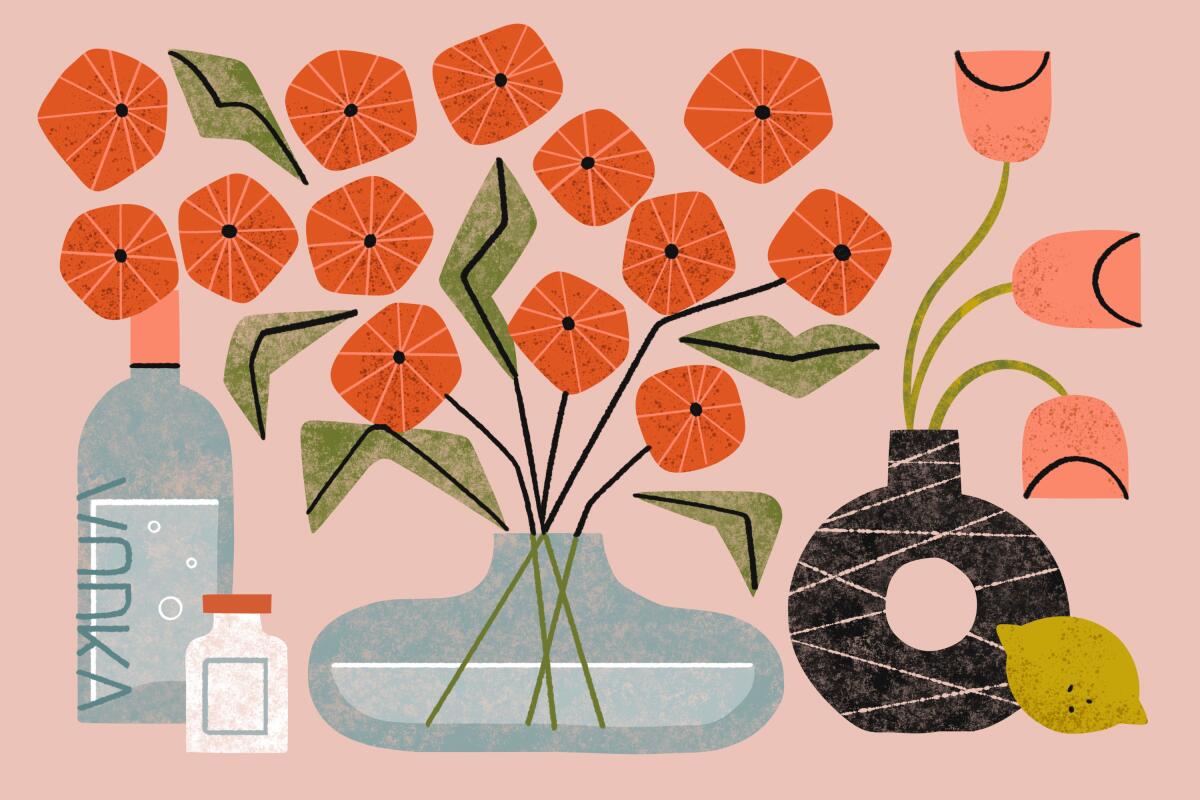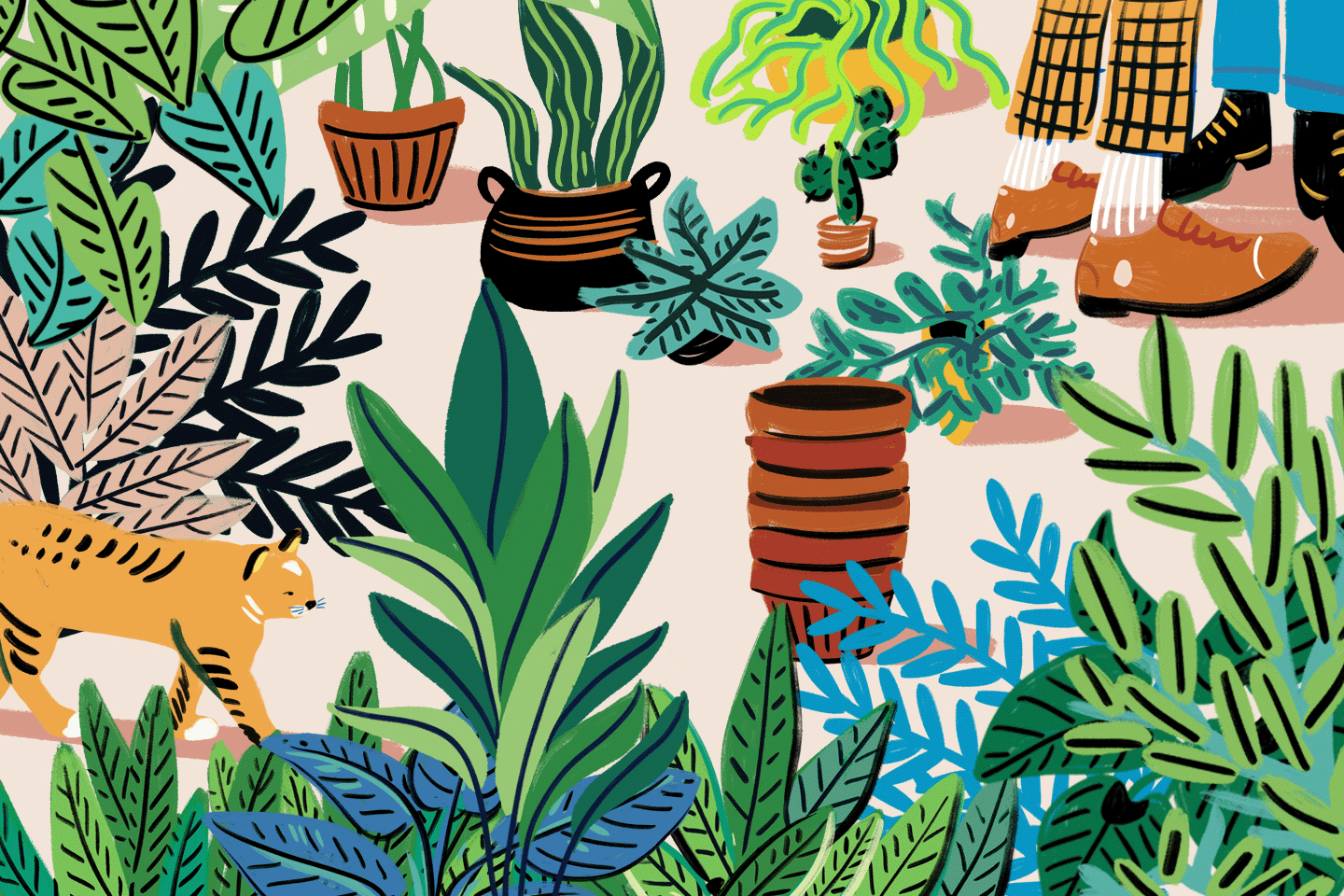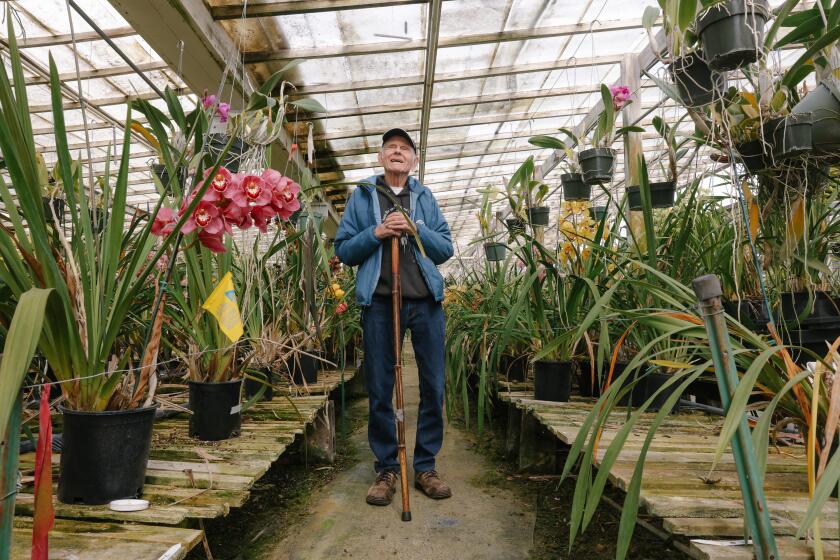What do Trader Joe’s flowers really need to stay alive? (Hint: Not the latest TikTok hack)

- Share via
The debate over how to take care of flowers probably began as soon as humans started cutting them and displaying them in vessels — enthusiasts have been encouraging people to stick a pin in each tulip stem or throw an aspirin into their vases for years.
Now with spring in full force and Mother’s Day around the corner, TikTok is flooded with videos from florists and flower lovers suggesting different ways to keep bouquets healthy for as long as possible. Some people swear by placing an ice cube, a shot of vodka and a penny dated before 1980 into their tulips’ water. Others endorse “forbidden lemonade” — a mixture of water, sugar, lemon juice and bleach that has been claimed to keep bouquets happy for two weeks. One florist suggests throwing out the flower food that comes with store-bought flowers, and opting instead for a few inches of water and a few drops of vinegar.
With dozens of different suggestions coming from all angles, you may be wondering what’s actually necessary to keep your flowers looking strong and fresh?
I went to the experts. The short answer is that for most flowers, you really just need fresh water in a clean vase. But there are still some things to consider around buying, displaying and tending to your new bouquets to help the blooms last. Here’s what you should know.
From tiny storefronts to longtime family-run institutions, we curated this list of our favorite places to shop for houseplants in and around L.A.
Consider your flower source
Trader Joe’s notably gets new flower shipments every day of the week, but many big-box supermarkets get flowers delivered only on certain days, meaning they can be past their prime before you even bring them home.
Joan Stevens, the flower farmer behind Mamabotanica Blooms in Pasadena, is wary of grocery store bouquets because of how long the flowers may have spent in transit or refrigeration.
“You can leave them [in the fridge] for weeks,” Stevens said. “And when you get them out, they’re just sad, and they’re all droopy. And then you put them in water, and they perk back up again.”
However, they won’t bounce back 100%, she said. “Just from a scientific, botanical perspective, there’s no way that a plant can lose that much of its turgidity — the positive water pressure that keeps its stem rigid,” she explains.
Choose the freshest blooms
Stevens instead urges people to buy flowers from local farmers. (If you’re looking for a farmers market in L.A., we have a database here.)
For the record:
8:39 a.m. May 5, 2023The Original Los Angeles Flower Market receives fresh flowers every day that it is open. A previous version of this post included a quote from FlowerSchool’s Tara Sandonato saying the market’s flowers are freshest Mondays and Wednesdays.
Tara Sandonato, the operations director and lead designer at FlowerSchool Los Angeles, picks up flowers every morning at the Original Los Angeles Flower Market, which receives new shipments daily (except Sundays, when it’s closed). Aside from picking bouquets whose blooms aren’t fully open, she suggests checking roses by gently squeezing the bottom of one flower’s head before purchasing them.
“If you do a light squeeze and it just feels firm, that’s a nice fresh rose,” said Sandonato, who has been working with flowers for 24 years. “If it squishes, it’s very old, like you might have two to three days max.”
TLC at home
Once the flowers make it home with you, it’s time to “condition” them by stripping extra foliage and trimming the stems. Stevens said it’s especially important to remove any leaves that would sit below the water line, since those can feed bacteria and cause the flowers to wilt.
“When you’re purchasing flowers, you’re really purchasing them for the bloom, like that’s where your money is going,” Sandonato said. “And so when we remove all that foliage, it’s allowing the water to only go straight to the bloom, which is going to make it last the longest.”
We test three different transportation options: driving, flying and shipping.
Retrimming the stems helps the flowers stay as fresh as possible. “If you recut the stems, they can re-uptake water and then they’re hydrated again, and they look good,” Stevens said.
Some kinds of flowers will require more specific conditioning. Hydrangea, for example, benefit from some extra effort. “The best way to make hydrangea last the longest is when you cut the stems, you want to put the stems — only stems — in hot water,” Sandonato said. “And if you actually smash the bottom of the stem and open it up, the water goes up a lot faster and drinks a lot better.”
Sandonato recommends changing the flowers’ water every day if you can. “Every other day is great too,” she said. “If you’re scared to take the arrangement out, you can flush it out in your kitchen sink.”
Where you display your bouquet also matters. “Keep your flowers in a cool spot out of direct sunlight and away from ripening fruit,” said Whit McClure, who runs a floral design studio called Whit Hazen. Fruits such as apples, bananas and mangoes emit ethylene gas, which causes flowers to mature faster.
But what about all those TikTok hacks?
As for the variety of items and substances people recommend adding to their vases, both Sandonato and Stevens stay away from them. (Though both of them occasionally use flower food, neither finds it essential.)
In her floral design classes, Sandonato is often asked about adding aspirin and pennies to flower water, though she always advises people to stick with fresh water. “When people hear these [hacks], they hear bits and pieces,” she said. “So the penny thing, technically it’s supposed to be old pennies, I think [from] the early ‘80s. And the aspirin, it has to be aspirin. It can’t be Tylenol, Ibuprofen, like, it’s very specific and people don’t always pay attention to that.” Adding substances such as vinegar, lemon juice, copper and bleach are all attempts at keeping the water disinfected, but they’re not as foolproof as people would like them to be.
Paul Gripp, 90, helped build the famed Santa Barbara Orchid Estate and will be there sharing tips during the International Orchid Show March 10-12.
As a flower farmer who studied permaculture and botany, Stevens sees these suggestions as unscientific advice. “I was a scientist before I was a flower farmer and often these people are like, ‘Oh, yes! Put the penny in! Do this and that!’” she said. “You never see them say, ‘Here’s the control. And here’s the experimental variable.’ And that’s critical. Otherwise, people are just making stuff up.”
One credible experiment that Stevens did come across was by Kristine Albrecht, a dahlia breeder based in Santa Cruz. In the video, Albrecht and her husband compare five flowers in five different substances: one control flower in just water; one flower that’s trimmed daily in water that’s changed daily; one in water with three drops of bleach; one in water with three drops of bleach, ½ teaspoon of sugar and ½ teaspoon of lemon juice; and one in water with FloraLife flower food. In the end, the vase with just water proved to be a clear winner.
The only trick that both Sandonato and Stevens vouched for is sticking a pin through the stem of droopy flowers about an inch below the bloom.
“You know what, that one works,” Sandonato said. “Only if it’s droopy. It doesn’t work every time, but I can say it does work most of the time.”
Still, even with all the proper care, it’s inevitable that your flowers will die.
“I can get a little bit philosophical about this,” Stevens said. “We live in a society that kind of has plasticized everything we have. We’re all trying to look 25 or whatever and we’ve forgotten the beauty of the other side of that.”
Therefore, she believes a simple way to enjoy your cut flowers for even longer is to appreciate their changing phases. She said she recently took photos of the wilting tulips that were still on her table because of the way the petals curled back and looked like “an alive thing.”
“A flower is part of a plant’s life cycle,” Stevens said. “Maybe we can actually really find beauty and pleasure in watching the fullness of its expression.”
More to Read
Sign up for The Wild
We’ll help you find the best places to hike, bike and run, as well as the perfect silent spots for meditation and yoga.
You may occasionally receive promotional content from the Los Angeles Times.














